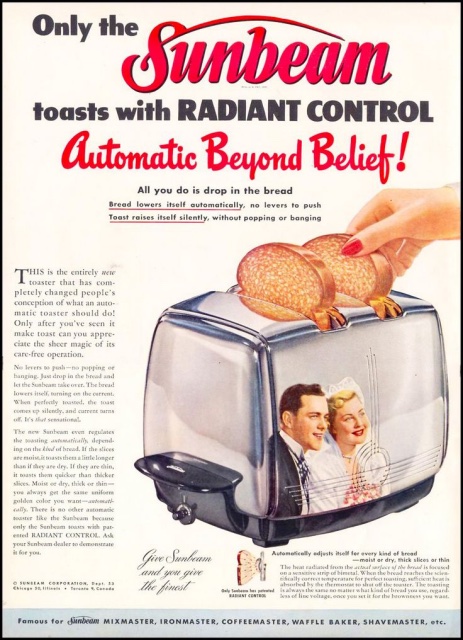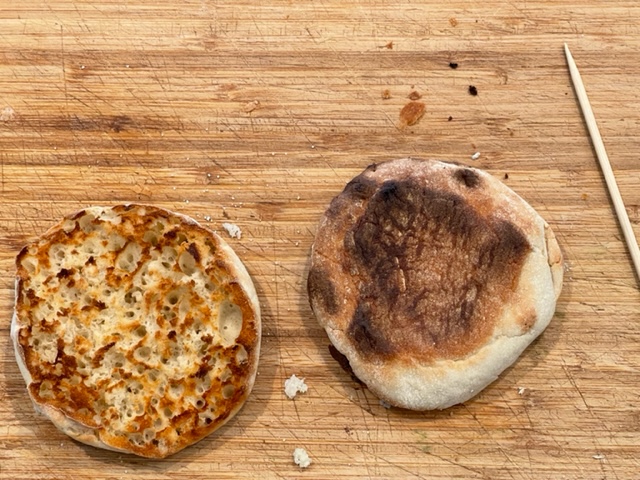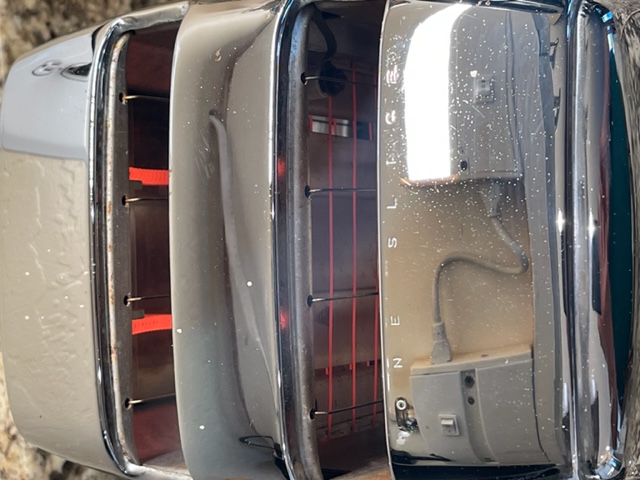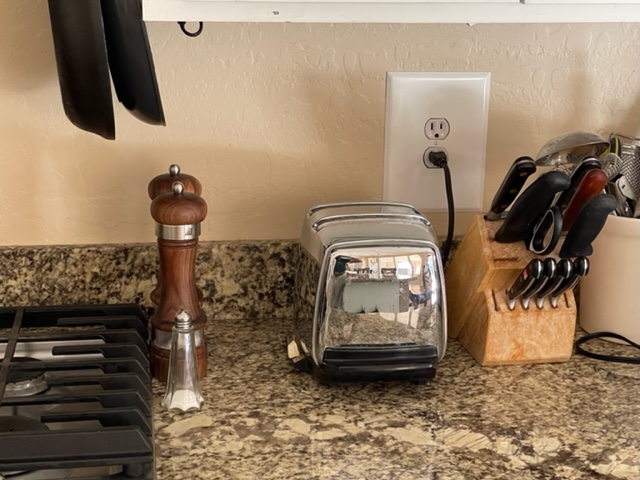A masterpiece of design.
For an index of cooking articles on this blog click here.
Designed and extensively patented in 1949, the Sunbeam Radiant Control toaster was sold from 1949 through 1995. It was made largely in America with a few manufactured in Canada and a few 230-250 volt models made in Australia.

Note the implication that the toaster makes a perfect wedding gift!
Click here for a larger version.
If the Leica M2 is a cult camera and the BMW Airhead is a cult motorcycle, then it’s only fair to add the Sunbeam to the cult population, because there is nothing in the toaster class made in the last seven decades which compares.
There is not one computer chip or electromagnet in the device. Just like in that Leica and BMW. Nor is there a down/up handle. A system of cantilevers sees to it that the weight of inserted bread lowers your future toast into the fires of hell, and at 1375 watts (from the VR-40-1 model; 1275 watts on earlier models) those fires run a great deal warmer than the 900 watts in your Chinese made piece of garbage. The resulting high temperature sees to it that the surface of the bread is seared to a satisfying crispness while the center remains soft and fluffy.

English muffins, toasted to perfection.
Once operational the innards disclose that the external heating coils are vertical while, mysteriously, the inner pair is tightly wound horizontally. Designer whim? Not a bit of it. This is a ‘Radiant Control’ tool. On insertion of the bread, the horizontal coils lengthen, due to thermal expansion, permitting the mechanism to relax and drop the bread into the body. The lengthening of the coils, once heated, is a mere fraction of a millimeter but a system of levers multiplies that some 175 times to effect the desired result. Ingenious. Vertical outside coils? Read on.
‘Radiant Control’? Never was there a more accurate advertising jingle. A bimetallic strip, shielded from the heat of the adjacent outside vertical coils, well remote owing to their vertical configuration, ‘sees’ the radiated heat emanating from the surface of the bread and releases the mechanism and disconnects power once the bread has reached the desired level of doneness. This means that it’s irrelevant whether the inserted bread is frozen or at room temperature, as the switch solves for radiation not for time. This also means that should you reinsert a toasted slice it will not be burned as the mechanism will recognize the high heat radiation rate and quickly release the toasted bread. Again, ‘Radiant Control’. I’m not sure why you would want to reinsert a toasted slice, but is that clever or what? A related benefit is that the mechanism will automatically adjust doneness whatever the thickness of the inserted bread. Again, it’s not timing anything. It’s sensing the heat radiated from the bread.

Horizontal and vertical heating coils.
While there were minor model differences over the 47 years this toaster was marketed by the Sunbeam Corporation, I can find no evidence that the related changes had any effect on reliability. Early models had lovely Art Deco scribed lines on the enclosure (T20, T20 A/B/C), some had a garish gold logo plate (T35), the doneness adjuster started as a knob concealed under one of the handles (supremely elegant – see the advertisement, above – through T35) then morphed into a slider on the long side (less elegant, if easier to use – T40 and later). But the patented Radiant Control mechanism remained unchanged. The early hidden adjuster design is optimal as, once you have established the color you like in your bread, it does not need adjusting. Thick, thin, moist, dry, frozen or at room temperature, the toaster will adjust the toasting time for the same result. So that control knob can be hidden from sight as it is rarely used. Move the knob fully counterclockwise or the slider all the way to the left and the toaster is turned off and the toast rises.
The functioning of the darkness knob or slider is as elegant as everything else in this device. It simply changes the distance of the radiation sensing bimetallic strip from the bread’s surface.
The Sunbeam has been ‘discovered’, largely I suspect owing to this quite special video from The Technology Connection. So unless you are lucky enough to find one at a yard sale from an uninformed seller, you can forget dreaming of picking one up for $10. A good one will run you $225 and up and if you think that is costly the toaster’s 1949 $25/sales price figures to $425 today. For that amount you could buy 17 WalMart specials or almost one Wolf but all would share the same electromagnets and failure-prone timer chips, making them so much recycled waste sooner rather than later. I got lucky and paid $145 after much searching for my early-1970s model in lovely condition (you really do not want a scratched chrome exterior). If the Sunbeam has a failure mode it’s that the retract/raise mechanism can get sluggish or non-operational, in which case a cleaning and a quick tweak on a hidden adjuster screw fixes what ails it. See “Adjustments”, below.

Beauty and engineering design.
Limitations? The Sunbeam cannot toast bagels. The radiant heat sensing bimetallic strip switch is directed at the center of the toast. This means it will ‘see’ the hole in the bagel and thus the heating coils behind that hole, and release the bagel far too early. Well, let’s face it. The bagel is the last word in sub-optimal design. You want a hole in the middle of your bread? What a rip off. And it’s loaded with oil, not to mention a wet cement-like dough consistency. Yecch! But that’s a minor limitation because each time you use the Sunbeam you will marvel at its ingenuity and sheer physical beauty while you anticipate beautifully toasted bread. And yes, it does English muffins perfectly! The British knew better than to leave a hole in the middle.
As regards bread size, it seems that American bread, like Americans, has grown larger since the late 1950s. The Sunbeam’s slot width is just over 5” so you may have to trim your slice a tad to fit.
As regards thickness, my breakfast favorite, the English muffin, needs a tad of ‘thinning’ to fit without shoving, something I accomplish by gently flattening the muffin before halving by pressing it under a cutting board.
But these are minor adaptations for what remains the best toaster in this universe.
Adjustments:
There are two adjusters on the Sunbeam – mine is the AT-W model. Be sure the toaster is unplugged before adjusting either.
The first, underneath the handle opposite to the cable entry, sets the degree of doneness for a particular setting of the darkness slider. In my case the slider had to be moved almost to full darkness for a medium toasted result. The screw can be seen with the aid of a flashlight and for the AT-W model is slotted. (Earlier models use a 3/32″ Allen screw). A half turn clockwise saw to it that medium toasted bread resulted with the darkness slider in the middle of its range. Stated differently, turning the adjuster screw clockwise means you have to move the slider towards the ‘lighter’ end for the same doneness that prevailed before adjustment. If your toast is too dark, turn that screw counterclockwise. My screw was pretty stiff. What is the right way to gauge whether you have adjusted this correctly? With no toast in the machine, depress the drop mechanism on the ‘One Slice’ side with a wooden spatula and count the seconds it remains engaged. Recall that the switch senses radiant heat when determining the heating time. With no bread in the toaster that will be a very short time as the heat falling on the bimetallic strip/switch will be high. You want the toaster to turn off and release the drop mechanism (‘click’) in 7-8 seconds from commencement of the heating cycle.
The second, visible when the crumb tray is swung open, controls the weight sensitivity of the drop mechanism. It’s a small slotted screw in the center of the chassis. My toaster was reluctant to drop the bread and a full turn counterclockwise on this adjuster screw restored its sensitivity. Drop in a piece of bread or an English muffin and down she goes, no poking or pushing required. If you buy a ‘faulty’ example there’s a very good chance that adjustment of this screw will restore an apparently non-functioning drop mechanism. What’s the right adjustment? Insert the slimmest, lightest piece of toast you are likely to use and make sure it drops without prodding. Keep adjusting that screw CCW, half a turn at a time, until it does.
Safety:
No Sunbeam Radiant Control Toaster came with a polarized (directional) electrical plug. From the T-35-1 model on, the electric switch is a double pole model, meaning the positive and neutral wires are switched, an important safety feature with the non-polarized plug used. If the plug is inserted the wrong way in the socket (and how are you to know the right was as it’s reversible?) or, even if you do know, if the electrician installing your power socket was a klutz and reversed the proper orientation of the positive and neutral wires – not unknown – then you can easily get an electrical shock from touching the wires even with the toaster off. For maximum safety with earlier models, where only the positive wire is switched, it’s a good idea to ensure the toaster is plugged into an outlet on a GFCI circuit. This will immediately trigger the GFCI circuit breaker in the event there is an electrical fault which allows current to flow to ground – like a shorted cord, for example, or a finger touching an earlier model’s wires. Installing a GFCI socket is a whole lot easier than opening up the toaster and rewiring early models for a polarized plug. (There’s a YouTube video out there on how to do this, but the presenter/mechanic is a total klutz). I’m not an EE so take your own advice on this one. Electricity, this Mech Eng has long known, is the work of the devil.
Buying advice:
As there were no dogs in the model line, any well priced Sunbeam will add class and design to your kitchen.
The T-20B added a more robust return mechanism. Models through the T-20C have the gorgeous Art Deco design scribed on the sides. The T20-C replaced the lovely cloth covered cord of earlier models with a more utilitarian rubber one. The T-35 replaces those with a gold logo, if that’s your thing. But these early models really should either be fitted with a three-wire polarized plug/cord for safety or used only with a GFCI socket. The T-35-1 was the first to use a two pole switch – safe – and the VT-40-1 increased power from 1275 to 1375 watts for a shorter toasting cycle. But the less attractive – to my eyes – darkness slider replaced the mostly hidden knob on early models. Thereafter variations on the theme were minor.
Mine is a late model AT-W, meaning it has 1,375 watts of power, the safe two-pole electrical switch, a rubber cord, and plain chrome sides with the frontal darkness slider.
A note about the inventor, Ludvik J. Koci:
From his obituary in the Chicago Tribune – the reference to the ‘Toastmaster’ is erroneous. That was a traditional design toaster from Sunbeam’s competitor, McGraw Electric:
INVENTOR, ENGINEER LUDVIK J. KOCI, 91
By G.J. Zemaitis. Special to the Tribune
Chicago Tribune
•
Sep 29, 1999 at 12:00 am
Ludvik J. Koci obtained his first patent in the mid-1930s and changed the way Americans lived.
The Chicago-born engineer was granted a patent for a thermostat that allowed him to invent numerous household appliances, including the Sunbeam Toastmaster.
A longtime Oak Brook resident, Mr. Koci died Monday in Lexington Health Care Center of Elmhurst. He was 91.
Mr. Koci was the son of Czech immigrants and the first in his family to attend college.
In a period of four years, he obtained electrical and chemical engineering degrees from the University of Illinois at Urbana-Champaign and went to work for the Chicago Flexible Shaft Co. in Chicago. The firm later became the Sunbeam Corp., for which he worked for 37 years.
“The family has a large briefcase filled with his patents,” said his daughter Cynthia Veldman. “But he was most proud of the Toastmaster.”
The Toastmaster stood out for its innovative ability to automatically lower and raise bread once it was toasted.
Mr. Koci also held patents for the first electric iron, the first electric coffee percolator, the first electric frying pan, and electric shavers and blankets.
Mr. Koci taught advanced mathematics at the Illinois Institute of Technology. Though an innovative thinker and inventor, he lacked sales skills, his daughter said.
“For the longest time, in the 1960s, we had prototypes of an electric bicycle and electric car that he built. He just could not get anyone interested in manufacturing them,” she said.
One of his inventions, an electronic turn indicator, was dismissed by several automobile manufacturers, which thought the idea was no better than a driver signaling by extending an arm from a moving car, she said.
“My father also loved music, particularly polka. As a young man, he was known as the king of polka,” said his daughter.
For a review of Koci’s gorgeous Sunbeam AP10 coffee percolator, click here.